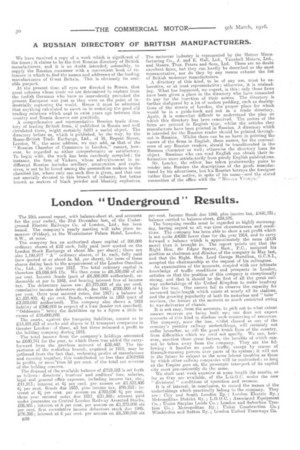London "Underground" Results.
Page 10

If you've noticed an error in this article please click here to report it so we can fix it.
The 18th annual report, with balance-sheet at, and accounts for the year ended, the 31st December last, of the Underground Electric Railways Co. of London, Ltd., has been issued. The company's yearly meeting will take place tomorrow (Friday), at the 'Westminster Palace Hotel, London, S.W., at noon. The company has an authorized share capital of 500,000 ordinary shares of £10 each, fully paid (now quoted on the London Stock Exchange at about 35s. per share); there are also 1,198,977 " A " ordinary shares, of 1s, each, fully paid (now quoted at or about 5s. 68. per share), the issue of these shares dating back to the acquirement of the London Omnibus Co., Ltd., in the year 1912. The total ordinary capital is therefore £5,059,946 17s. We then come to £6,330,050 of six per cent. Income Bonds (part of £6,500,000 authorized), redeemable at par in 1948, and hearing interest free of income tax. The debenture issues are: ,£1,273,000 of six per cent. cumulative income debenture stock, due 1945; £700,000 of 4i per cent, three year secured notes, doe 1917; a balance of £1,832,490, 4 per cent, Bonds, redeemable in 1933 (part of £3,000,600 authorized). Tho company also shows a 1915 liability of £390,060 in respect of a loan (lender not specified). "Oddments " bring the liabilities up to a figure a little in excess of £l6000,000.
Thu assets, against the foregoing liabilities, consist as to £14,521,613 of stocks and shares in 11 transport companies' in Greater London : of these, all but three returned a profit to the holding company during 1915.
The total income from the company's holdings amounted to £680,741 for the year, to which there was added the carryforward from the previous account of £38,442. The importance of the, motorbus branch, acquired in 1912, may be gathered frum the fact that, reckoning profits of manufacture and running -together, this contributed no less than £362!058 in profits, or morctthan 53 per cent, of the total net revenue of the holding concern.
The disposal of the available balance of £719,183 is set forth as follows : directors', trustees' and auditors' fees, salaries, legal and general office expenses, including income tax, etc., £11,813; interest at 44 per cent. per annum on £1,832,400 14 per cent, Bonds due 1933, plus income tax, £95,252; interest at 4L per eent, per annum on £700,900 4 per cent. three year secured notes due 1917, £31,500; amount paid under guarantee on Central London Railway Assented Stocks, £26,931 ; interest at 6 per cent, per annum on £1,273,000 six per cent, first cumulative income debenture stock due 1945, £76,380; interest at 6 per cent. per annum on £6,330,050 six
B36 per cent, Income Hem& due 1948, plus income tax, £438,731; balance carried to balance-sheet, £38,576. . The foregoing results moat be regarded as highly encouraging, having regard to all war-time, circumstances and condi tions. The company has been able to show a net profit which it not quite £4000 lower than for the year 1914, and to carry forward a balance which is approximately the same (£134 more) than it brought in. e The report points out that the Right Hon. Sir Edgar Speyer, Bart., P.C., resigned his position as chairman and director of the company in May last, and that the Right. HUM Lord George Hamilton, G.C.S.I., accepted the chairmanship at the request of his colleagues. An examination of the accounts, coupled with our intimate knowledge of traffic conditions and prospects in London, satisfies us that the position of this company is exceptionally strong, and that it should be the first of all the great rail way undertakings of the United Kingdom to make headway after the war. One cannot fail to observe the capacity for
increased. train-length which exists at nearly all its stations, and the growing popularity of both its motorbus and "tube" services, the former at the moment so much restricted owing to war-deliveries of chassis.
It is noteeasy, from the accounts, to pick out to what extent unseen reserves are being built up; one does net expect
accounts of this kind to disclose such conserving of resources.
The company, none the less, whilst classed as one of the country's premier railway undertakings, will certainly not suffer hereafter, as will the great trunk lines of the country, from difficulties which we need not specify. We can, however, mention three great factors, the benefits of which can not be taken away from the company. They are the fol lowing: it handles no goods traffic, except by reason of through-running powers over parts of its system ; it will not in the future be subject to the same labour troubles as those by which other railway companies will be confronted; so long as the Empire goes on, the passenger transport of its capital city must pre-eminently do the same.
We shall next week examine at some length the results, so far as they are available, a the L.G.O.C. under the new "divisional " conditions of operation and revenue.
It is of interest, in conclusion, to record the names of the undertakings which practically belong to the company. They are : City and South London fly. ; London Electric Ry.; Metropolitan District fly. ; L.G.O.O. ; Associated Equipment Co.; Union Surplus hands Co.; Londen and Suburban Traction Co. ; Metropolitan By.; Union Construction Co.; Wimbledon and Sutton By.; London United Tramways Co.






















